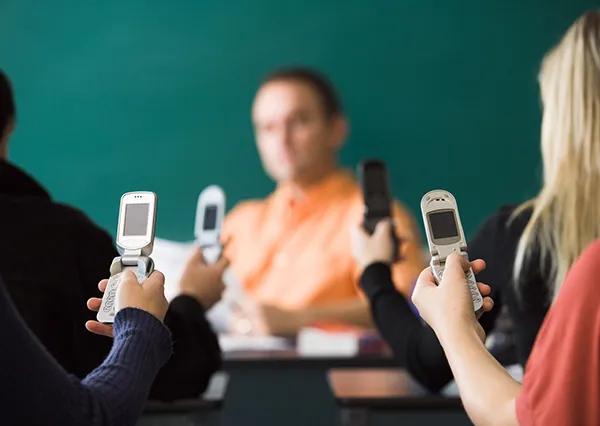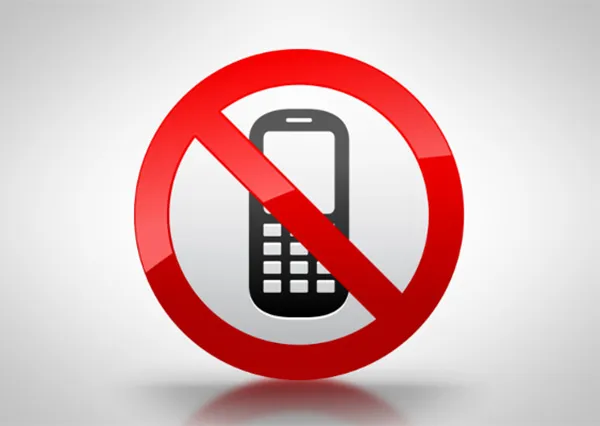
Many educators are having trouble figuring out how to handle electronic devices in the classroom. Some have been educating students on the negative effects, encouraging them to regulate their own use. Others have even highlighted possible applications for mobile devices in the classroom. Though, many just try to ban everything. A principal in British Columbia took his school's ban to a new level by setting up a cellphone jammer. There was just one problem -- the device is illegal in Canada. The principal had ordered the Chinese device online, but some angry students were quick to find out and inform him that he was breaking the law. So much for that idea. Now, he's left looking pretty bad while cellphone use in school now seems like some kind of civil rights issue to some students. Of course, for the education workers, his approach makes some sense. As an educator, no one wants to see students using mobile phones in class or in exams

Mobile Phone affect learning initiative
Now almost every student in a school own their cell phones. What’s worse, cell phones have become many students’ “weapon” against their teachers. Most students are found using their cell phones to surf on the internet during a lecture; many students tend to listen to music or play video games in classroom; it frequently happens that a sudden cell phone ring during a classroom lecture often arouses distractions; or even worse that some students make use of cell phones to help them cheat in an exam…. It has been reported that a new phenomenon “cyber bullying” refers to that students electronically torment others via text messaging and social networks, when they should be paying attention to lectures.

Some countries are allowing businesses and government organizations to install GSM Jammer in areas where cell-phone use is seen as a public nuisance. In December 2004, France legalized cell-phone jammers in movie theaters, concert halls and other places with performances. France is finalizing technology that will let calls to emergency services go through.

India has installed jammers in parliament and some prisons
It has been reported that universities in Italy have adopted the technology to prevent cheating. Students were taking photos of tests with their camera phones and sending them to classmates.
Since a classroom usually is not of very large area, then a portable mobile phone jammer is recommended, which is quite convenient to carry and put into use– What you need to do is simply press the button to switch it on. Surely, you needn’t worry about an emergency that someone needs to make a phone call, they can just walk out the classroom and make the call without disrupting others.

Or you can just switch off the jammer unit when needed
Mr. MacNeil has taken steps in the past to prevent use, including the purchase of a cell phone jammer , a device that cuts out service. The device is considered illegal, yet no one has been prosecuted in the United States for having one, he said. Mr. MacNeil added that at the time he purchased the jammer, he talked to the teachers in neighboring classrooms about it, who were in full support. The jammer is less effective at this point because it has become outdated. It only blocks up to 3G signal, and students with smartphones can still use WiFi.

My girlfriend had a professor who would simply demand the student stand up and read the content of the text message aloud to the class, and then explain the conversation to which it pertained. His usual line was "Since your text message is clearly more important than the lesson I am trying to teach, why don't you share it with us, so that we can all benefit from it's information." After the first embarrassing text that gets read, the cell usage drops dramatically. Using a short range cell jammer during exams is not unreasonable. In my opinion a professor has a duty to do everything in his/her power to prevent cheating on an exam.

The challenges of using mobile phones in educational settings, especially in the classroom, are becoming increasingly apparent.
Let’s delve deeper into these issues and explore potential solutions:
- Educators face the dilemma of addressing the negative effects of excessive mobile phone use while also recognizing the potential benefits of integrating technology into learning.
- Some schools have launched educational programs to raise awareness among students about the harmful effects of mobile phone distractions and encourage responsible use of mobile phones.
- Emphasizing the educational potential of mobile devices, such as accessing educational applications, conducting research, or collaborating on projects, can promote constructive use in the classroom.
- While the use of mobile phone jammers as a means of enforcing mobile phone bans is attractive to some educators, it raises legal and ethical concerns.
- In countries such as Canada where mobile phone jamming devices are illegal, attempts to implement such measures may result in legal consequences and public backlash.
- Ethical arguments continue to arise regarding the infringement of students’ rights and freedoms and the potential disruption of emergency communications services.
- Technological advances offer alternative solutions to manage mobile phone use in the classroom without resorting to illegal means.
- Portable mobile phone jammers, while controversial, offer a temporary solution to prevent distractions during exams or lectures. However, their legality and effectiveness remain to be determined.
- Other technology approaches, such as mobile device management (MDM) software, classroom management apps, or web-based solutions, provide more granular control over device use while complying with laws and regulations.
Managing cell phone use in the classroom requires a nuanced approach that balances educational goals, legal considerations, ethical principles, and technological solutions. By fostering a culture of responsible technology use and implementing effective strategies, schools can create environments that promote learning, engagement, and academic integrity.







